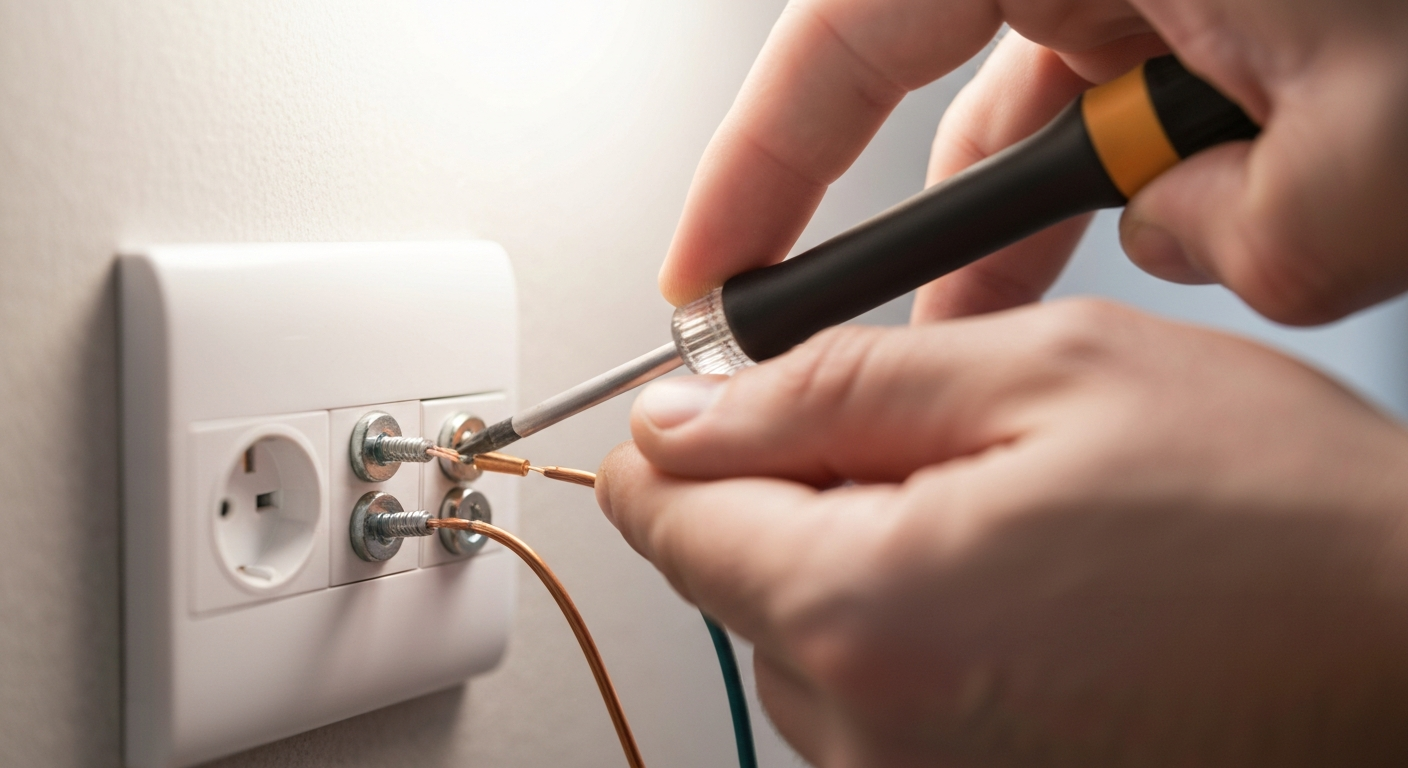
Don’t Get Tripped Up: Common GFCI Miswires Under NEC 2023 and How to Fix Them
This article dives into the most frequent GFCI miswires a qualified electrician might encounter, explains the symptoms, and covers the correct practices to ensure a safe and compliant installation every time, all under the guidance of the 2023 National Electrical Code.
What’s New? A Quick Look at NEC 2023 GFCI Requirements
The 2023 NEC continues the trend of expanding GFCI protection to more areas, reflecting a deeper understanding of shock hazards. The updates in NEC 210.8 are significant for both residential and commercial work. For dwelling units, it’s important to distinguish between two key rules: NEC 2023 210.8(A)(6), which mandates GFCI for receptacles serving kitchen countertop surfaces, and 210.8(A)(7), which requires protection for receptacles within six feet of a sink. While not a new rule, the distinct application of the sink-proximity requirement in areas other than kitchens is a critical point of compliance.
Other key expansions include:
- Expanded Outlet Protection: GFCI requirements have been expanded in locations like basements and garages to include certain 240-volt receptacles, which may affect circuits for large appliances in those specific areas.
- Non-Dwelling Units: The rules for non-dwelling unit GFCI protection have broadened. Per NEC 2023 210.8(B), in locations like commercial kitchens and break rooms, GFCI protection is required for receptacles supplied by single-phase branch circuits rated 50 amperes or less and three-phase branch circuits rated 100 amperes or less, where the circuit is 150 volts or less to ground.
- Outdoor Outlets: Requirements for outdoor outlets have been clarified. When you replace an existing receptacle at an outdoor location for a dwelling unit, garage, or accessory building, that replacement receptacle must be upgraded with GFCI protection per NEC 406.4(D).
The #1 Culprit: Line-Load Reversal
By far, the most common error in GFCI installation is the classic line-load reversal. This happens when the incoming power from the panel (the “line” wires) is incorrectly connected to the “load” terminals of the GFCI receptacle, and the outgoing wires feeding other receptacles are connected to the “line” terminals.
The symptoms of a line-load reversal can be confusing. On older GFCI models, the face of the outlet might have power, and a simple plug-in tester might light up, giving a false sense of a correct installation. However, the device will have no ground fault protection, and it won’t provide any downstream protection to other outlets on the circuit. On most modern GFCIs, this mistake is easier to spot because the device simply won’t work or reset, as a built-in safety mechanism. If you encounter a GFCI that trips but remains live, a line-load reversal is a likely cause.
The Fix: The solution is straightforward. Always use a voltage tester or a non-contact voltage pen to identify the “line” side—the wires that are energized when the breaker is on. Turn off the circuit, verify the power is off, and connect these identified line wires to the terminals marked “LINE” on the back of the GFCI. The outgoing wires that feed other receptacles connect to the “LOAD” terminals. This correct wiring is essential for both the GFCI’s own protection and for any feed-through GFCI functionality.
Other Common GFCI Wiring Blunders
While line-load reversal is the top offender, a few other wiring issues can cause headaches and safety risks.
Reverse Polarity Wiring
A simple but dangerous mistake is reverse polarity wiring, where the hot and neutral conductors are swapped. The hot wire connects to the silver (neutral) terminal, and the neutral wire connects to the brass (hot) terminal. A GFCI with reversed polarity may still pass its own internal test and might even trip during a ground fault. However, this is a serious code violation because it leaves the connected appliance’s components energized even when a switch is in the “off” position. When it comes to receptacle termination types and ratings, getting polarity right is a fundamental safety step.
The Fix: Use a receptacle tester to immediately identify reversed polarity. Turn off the circuit and swap the hot and neutral wires to their correct brass and silver terminals, respectively.
The Open Ground Problem
In older buildings without a dedicated equipment grounding conductor, a common upgrade is to install a GFCI receptacle to provide shock protection. This is a permitted and safe practice under the NEC, but it can lead to confusion. A receptacle tester plugged into this GFCI will correctly show an open ground, which may cause concern if you’re not expecting it. A GFCI itself does not need a ground wire to function; it works by sensing an imbalance between the hot and neutral currents.
It’s a myth that an open ground will cause a GFCI won’t reset issue. The GFCI will reset and function normally. It will trip if it senses a ground fault, protecting a person from shock.
The Fix: This isn’t a wiring “fix” but a labeling requirement. Per the NEC, a non-grounded receptacle protected by a GFCI must be labeled “No Equipment Ground” and “GFCI Protected.” This informs users that while shock protection is present, the outlet cannot provide a ground path for equipment or surge protectors.
Shared Neutrals on a Feed-Through GFCI
Multi-wire branch circuits (MWBCs) can create instant tripping issues when a feed-through GFCI is installed incorrectly. If a GFCI receptacle is installed on one circuit and its “load” side neutral is connected to a neutral that is shared with another circuit, the GFCI will trip immediately upon any load being applied to the other circuit. The GFCI’s internal sensor sees current returning on the neutral that didn’t originate from its own hot conductor, interpreting this imbalance as a ground fault.
The Fix: There are a few ways to resolve this. The best practice is often to install a 2-pole GFCI circuit breaker that protects the entire MWBC at the panel. Alternatively, you can stop the feed-through protection at the GFCI outlet. This involves making pigtail connections for the line-side wires and leaving the load terminals unused. Proper handling and grouping of conductors in a multiwire branch circuit is crucial for this method to be safe and effective, as outlined in NEC 2023 210.4(D). Understanding how to calculate outlet box dimensions according to the 2023 NEC is helpful in these more complex scenarios.
Best Practices for a Flawless Installation
To avoid these common pitfalls, adhere to a strict installation and verification process.
- Always Identify Line Wires: Never assume. Use a voltage tester to definitively identify the incoming power source before connecting any wires.
- Follow a GFCI Testing Procedure: After installation, first use the test/reset buttons on the device. Then, use a dedicated plug-in GFCI tester to ensure the device trips under a simulated fault. This verifies that your Class A GFCI is working to standard.
- Ensure Readily Accessible Location: For the locations covered in NEC 210.8, the code specifies that GFCI devices must be installed in a readily accessible location. This ensures they can be reached for testing without moving large objects or using tools, allowing the end-user to perform recommended monthly tests.
Mastering GFCI installation is about more than just meeting code—it’s about upholding your professional standard and ensuring the safety of those who use the spaces you wire. By staying current on the latest nec 2023 gfci requirements and being vigilant about these common wiring errors, you can prevent callbacks and deliver the life-saving protection these devices are designed to provide. If you’re looking to deepen your knowledge of the latest code changes, ExpertCE offers a range of courses to keep you at the top of your game. Browse our courses to stay ahead.
Disclaimer: The information provided in this educational content has been prepared with care to reflect current regulatory requirements for continuing education. However, licensing rules and regulations can vary by state and are subject to change. While we strive for accuracy, ExpertCE cannot guarantee that all details are complete or up to date at the time of reading. For the most current and authoritative information, always refer directly to your state’s official licensing board or regulatory agency.



